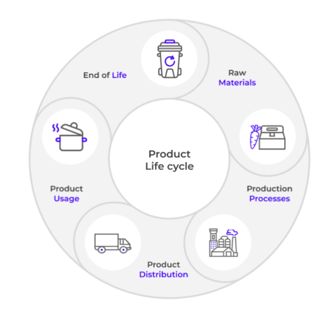An Introduction to Life Cycle Assessment (LCA)
Understanding Environmental Impact from Start to Finish
Life cycle assessment (LCA) is a method for quantifying the environmental impacts of products or services throughout their entire life cycle, offering a holistic view from raw material extraction to end-of-life disposal. The approach considers every stage of a product’s journey, emphasising the connections between resource use, emissions and environmental impacts.
Everything has a Life Cycle
Every product or service that is created undergoes a series of stages, which each contribute to its overall carbon & environmental footprint:
- Raw material extraction: The initial stage where raw materials are extracted and prepared either for direct use in the product, or for the energy and equipment used to create it.
- Production: Where raw materials are transformed into ingredients and parts for the final product
- Distribution: The process of getting the product to the consumer, including transportation and storage
- Usage: The consumer’s use of the product and its energy or resource requirements
- End of Life: Disposal, recycling, or repurposing of the product

Creating a Comprehensive Inventory: Summing Up the Flows
Through assessing all of the interactions, both direct and indirect, with the environment an inventory is assembled. Direct interactions include how much water was extracted, or how much carbon was released, whereas indirect interactions include the impact related to a truck that transports a given product or material. The raw data is then transformed into insights that quantify the impact (positive or negative) allowing us to understand the overarching impact a product has on the environment.
In an LCA, the impact is quantified per functional unit, which in the case of Sustained, with a focus on the food industry, could for example be 1kg of a frozen lasagna or 1kg of ground coffee beans, or it could be per individual product (a stock keeping unit or SKU) like 230g of that lasagna. Either way, the LCA would encompass all the resources going into the product before the purchase as well as those later on, such as heating it up and the disposal as well as the treatment of any packaging or food waste.
LCI Databases: The Backbone of LCA
The accuracy of a LCA heavily relies on Life Cycle Inventory (LCI) databases, repositories of data on the environmental exchanges involved in producing materials, products and services. At Sustained, we utilise leading databases like Evoinvent and Agribalyse for their reliability and transparency, but we are also continuously monitoring what other databases are out there and whether we can improve our system with any of them.
Selecting the most suitable methodology
The underlying methodology for an LCA defines which environmental aspects (i.e impact categories) are considered and how impacts are calculated and allocated. At Sustained, we focus on the Product Environmental Footprint (PEF) framework and GHG protocol, while our system can scale and adapt to other methodologies, to support the evolving needs of customers worldwide.
The PEF framework was developed by the European Commission's Joint Research Centre. Updated in 2018, PEF covers 16 impact categories and summarises them into a single indicator to allow for an easier interpretation of the results, comparing the impact to an average person’s annual environmental footprint. This comprehensive framework aligns with our commitment to provide insightful and actionable environmental assessments, and you can read more about why we chose PEF in this blog post.
In addition, the GHG protocol methodology can also be selected as an evaluation method in Sustained for Product Carbon Foot printing. The GHG protocol was initiated 1998 by the World Resources Institute (WRI) and the World Business Council for Sustainable Development (WBCSD) and has since been continuously developed. While the GHG Protocol focuses only on global warming, it is the underlying standard for several reporting frameworks such as CDP, and it is the backbone of the voluntary Science Based Target initiative (SBTi).
Understanding the environmental impact of your products throughout their life cycle is more than an exercise in data collection; it’s a step towards iterative and tangible sustainability. By partnering with Sustained, companies can test out fast, cost effective LCAs starting with just ingredient and packaging data. To see how fast it can be to get started, book your demo today.
-1.png?length=384&name=Blog%20header%20(5)-1.png)
.png?length=384&name=Blog%20header%20(7).png)